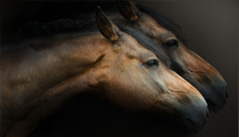
|
|
Equine chiropractic care
Chiropractors define a VSC (referred to as a “subluxation”) as the functional misalignment of a vertebra or the limited mobility of its facet joint.
If a subluxation exists, the horse loses normal flexibility of its spine, affecting performance and resulting in stiffness and muscular tension. Reduced mobility between two vertebrae can affect the nerves that leave the spinal cord between two adjacent vertebrae.
Negative alteration in the nerve’s function can lead to interference in the flow of stimuli or information which is necessary for smooth coordination of the body functions and muscle contractions.
Every movement, from a slight twitch of the tail to the complicated piaffe in dressage is made possible by synchronizing many muscles. If the function of the nerve fibres, which innervate the muscles, is altered, coordination deteriorates.
Small disturbances are usually only caused by a slight interference; however, they can keep the horse from performing at its best in demanding exercises.
Missteps resulting from lack of coordination may cause injury to other joints and tendons or ligaments in the legs.
An animal with a subluxation will change it posture to compensate for the restricted mobility of its spine and to avoid pain. This triggers increased mechanical strain on other parts of the spine and extremity joints, causing secondary restrictions and deterioration of the condition.
 |
Illustration of a VSC. The spinal cord is the “ information highway” allowing the transmission of information between the brain, muscles, skin and all organs. |
Different equestrian disciplines can cause specific subluxation patterns :
For example:
- Dressage horses with subluxation in the lumbar spine have difficulty bending correctly and executing lateral movements. Further consequences include poor engagement of hind limbs and a lack of suppleness.
- Show jumpers with subluxations in the lower thoracic and lumbar vertebrae have difficulties rounding their backs. They often land in cross canter and have problems changing the lead in canter.
- Gaited horses with subluxations of the sacroiliac joint have an unlevelled gait rhythm and difficulty with transitions. They also have a tendency to lean into the bit and run off. Their backs may be tense, muscular atrophy may also be evident.
- Endurance horses with subluxations in the thoracic and cervical spine often demonstrate soreness in the back and unleveled gait rhythm. Further effects are a noticeable drop in performance as well as a stiff neck.
- Driving horses with subluxations in the thoracic and lumbar vertebrae drop one shoulder, move on two tracks and tend to pull or show gait abnormalities.
- Western horses with a restriction in the lumbar vertebrae and sacroiliac joint have difficulty in bending laterally and show singlesided problems in turns and spins, as well as undefined lameness in their forelimbs.
Common causes of vertebral subluxation complexes
Back to the top Powered by quicksite v 4.6.7© 2002-2019 All rights reserved
Powered by quicksite v 4.6.7© 2002-2019 All rights reserved
